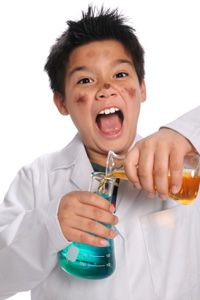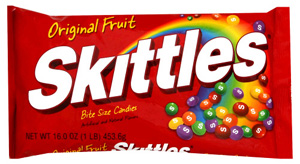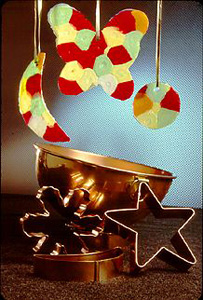Houses across America have either already been inundated with bucket loads of candy, or they’re starting to brace themselves for Sunday night’s onslaught. Kids aren’t the only victims of the sugar high and calorie binge that’s about to take place, moms and dads are just as, if not more, likely to dip their hands into the trick-or-treat stash. 
What to do? Sure you could handout toothbrushes… but really? Temporary tattoos, scary baby carrots, goody bag yo-yos and sugar-free gum are all healthy alternatives, but where’s the fun in that? Put that candy to good use!
Go ahead and let your kids rake in as much candy as possible. Then, spend an afternoon experimenting with the candy! Instead of burning brain cells on refined sugar, fuel their brain cells with fun-filled knowledge.
We cruised around the Web and found some pretty cool candy experiments. All of these make for some cheap fun that uses all that Halloween loot in a practical, fun and non-wasteful way. Just like in high school chemistry… don’t eat anything in the lab!
Skittles Density Rainbow – CandyExperiments.com
You won’t get to taste the rainbow on this one but you will get to create one. Kids and adults alike will marvel at how the colors separate in a bowl to produce a perfect ROYGBIV rainbow. Set-up two bowls next to one another to create a homemade double rainbow!
Floating Ms – TheTeachersCorner.net
You’ll need a bowl, water, and some of the fun-size packs of M&Ms. Watch closely as the candies floating in water start shedding their color-coated skin. Have the kids guess which part of the candy will be the last to go!
Will it Float? – CandyExperiments.com
It’s the home version of David Letterman’s late night game. You’ll need a variety of candies, like 3 Musketeers, Kit-Kat, hard candies and anything else you’ve got in that bucket. Fill a few small bowls with water and drop in the candy. Have everyone hypothesize which will float and which will sink.
Chromatography – Chemistry.About.com
Kill an hour, and a few bags of Skittles, with your older mini scientists, and learn all about chromatography, a process of separating and analyzing different chemicals. You’ll need the candy, coffee filters, pencil, toothpick, water, salt, foil, empty two-liter, and measuring cups.
Fat Test – CandyExperiments.com
You’re mostly right if you think those little candies are solid pieces of sugar. However, most chewy candies, like Starburst, contain oil, too. Use these candies, your microwave and a microwavable plate to find the oil that rises to the surface of this sugary puddle.
Glow in the Dark – Science20.com
Some are old enough to remember the commercial encouraging you to take a Wint-O-Green Lifesaver into a dark room, bite into it, and wait for the spark. This is a fun test with kids of any age.
Stained Glass Ornaments – Science20.com
More craft than science, this is an efficient way to get rid of the hard candies and suckers that no one really wants to eat anyway. Melt them down, pour into cookie cutters and use a straw to make a hole for a ribbon. The finished product is a beautiful stained-glass looking ornament you can use in a few weeks to decorate the tree. (Image via Science20.com)
Rotten Pumpkins – Suite101.com
Before you toss those Jack-O-Lanterns in the garbage, use them for one last experiment. Cut them in half with one going outside and one staying inside. Kids can witness the decomposition process, learn about mold, dehydration and more.
Let the kids wear rubber gloves, an apron from the kitchen and even their swimming goggles to let their imaginations run wild and really feel like mad scientists while devouring their candy stash in your at-home science lab!
Also Read:
Healthy Halloween Recipes for Kids
